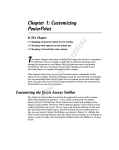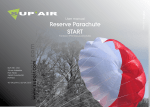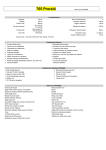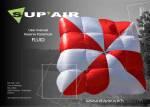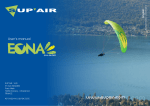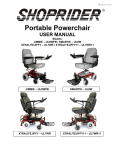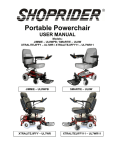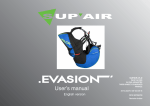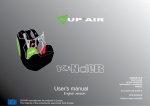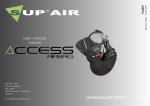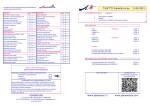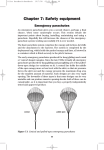Download User`s manual
Transcript
Reserve chute User’s manual SUPAIR-VLD parc Altaïs 34 rue Adrastée 74650 Annecy CHAVANOD FRANCE Reserve chute Thank you for choosing a SUP’AIR reserve We are glad to be able to join you in a common passion : paragliding! parachute! SUP’AIR has been designing, manufacturing and distributing accessories world wide since 1982. Choosing a SUP’AIR product is the right choice for anyone to make, for it is supported by thirty year of expertise and innovating designs driven by customer feedback always taken into account. It is a philosophy : always thriving on improving our product line while delivering quality gear to the world market. TABLE OF CONTENT Product characteristics Norm Use Setup Packing Maintenance & Warranty Next, are explicit instructions to familiarize yourself with the products technical features. Please, carefully read the following content! Visiting our website at www.supair.com , will also bring you the latest updates. Additionally, if in doubt, questions will be answered by contacting any of our network representatives. Naturally the entire SUP’AIR Team will be at you disposal for quick replies to your inquiries at [email protected] We wish you the best of flights. The SUP’AIR team. Parachute Supair Light User’s manual OUR PRODUCT LINE supair xtralite reserve Minimal weight and volume / optimal stability. SUP’AIR has been working and developing reserve parachutes in close cooperation with SKY PARAGLIDERS for many years. The lightest certified reserve parachute model on the market. Ideal for hiker / flyers to keep their overall gear weight to a minimum. Theses products are innovative while emphasizing on opening speed, stability and low sink rate. We only use proven materials in order to guaranty the highest compromise quality / performance possible. Our products are manufactured following specific guide lines to insure conformity and full compliance with the ISO 9001 version 2008. The parachute gores are cut on a numerical computerized automated CNC table in order to obtain a zero default tolerance level, thus bringing consistency to the process. Certification Maximum sink rate : 5.5 m/s ( during laboratory tests ).Porcher Sport Fabric, PA 6,6, 33 dctex, 40 g/m²Cousin Trestec SA. suspension lines. Cousin Trestec lines for easier handling and higher strenght.Automated computerized assembly and stiching system Fabric computerized panel cutting Characteristics : Model Size S Size M EN 12491 et LTF 35/03 Sink rate : 5,5 m/s with maximum load during laboratory measurement tests.Line material : Cousin Trestec for its overall qualities and strength.Cloth : Porcher Sport, PA 6.6 high tension strength, 22 dctex, 30 gr/ m2. Pull-down type Apex system.Automated assembly and stitching. Computerized CNC panel cutting process. delivered with 145 cm « Y « risers ( 120 gr. ) and two 6 mm stainless steel ( Inox ) rectangular Maillons Rapides for the connection harness / wing ( 84 gr. for the set ) - loop to loop connection on the reserve parachute side. Hooking weight : minimum Hooking weight : maximum certification EN 12491 and LTF 35/03 Characteristics : elivered with a 145 cm ( 120 gr. ) « Y « riser configuration and two 6 mm D rectangular Maillons Rapides for the harness / wing attachment points ( 84 gr. for the set ) - loop to loop connection On the tandem reserve parachute side, delivered with a 190 cm. « Y « Rose riser system + two 6 mm. trapezoidal ( Delta ) stainless steel ( Inox ) Maillons. Size L Model Hooking weight : minimum Hooking weight : maximum Size S Size M Size L tandem 60 Kg 70 Kg 85 Kg 140 Kg 80 Kg 95 Kg 115 Kg 210 Kg 60 Kg 80 Kg 100 Kg 85 Kg 110 Kg 135 Kg weight 1 210 g 1 510 g 1 850 g weight 990 g 1 190 g 1 410 g 2 750 Kg Surface area 22,5 m2 26,25 m2 28,9 m2 Surface area 20,5 m2 24,4 m2 28,9 m2 55,9 m2 Gore number 13 14 18 Gore number 14 16 18 20 www supair com page 3 EN 12491 norm Flight test European Norm 12491 User’s manual this guide conforms to requirements as set out in regulation EN 12491 The reserve parachute certification code EN 12491 is described as follows: - Flight proper sequence : during a straight flight, the reserve parachute is deployed. In order to conduct accurately reproducible tests by avoiding any interference from the paraglider, the test-pilot releases his paraglider at peak height during a roll to begin with an important instability level. •The maximum sink rate is measured during the last 30 meters, the paragliding wing is released, below or equal to 5,5 m/s under maximum load. •Stability is checked in a subjective visual way ( with a rolling effect or not ), and is gauged against the overall sink rate ( an unstable reserve parachute usually demonstrates a higher sink rate). •The reserve parachute opening speed must be inferior to 5 seconds. - Structural tests ( resistance ): consists of verifying the overall structural integrity of the parachute under maximal load for a given horizontal 40 m/s speed. There can not be any failure / damage taking place on the entire riser / lines / canopy cascade during the entire procedure. Opening speed + Wing jettisoning STABILITY Sink rate < 5,5 m/s at maximum load. The certification results can be found at www. supair.com www supair com page 4 User’s manual Structural test European Norm 12491 Horizontal speed 40 m/s or 144 km/h at maximum load. www supair com page 5 RESERVE PARACHUTE User’s manual OWNER’S MANUAL We recommend the following procedures concerning our reserve parachute line : To begin with, we must stress that using a reserve parachute should never be taken for granted or considered to be without risks to the pilot. A reserve parachute is only there to deploy in case of an emergency situation. A pilot’s weight must correspond to the manufacturer recommended range limitations to be fully operational. Any intent to use a reserve parachute below or above the manufacturer’s recommended weight limitations is dangerous and must totally be avoided. - Any reserve parachute riser connection to the harness must result with the pilot landing on his legs and standing. The parachute must be left unmodified to keep it aligned with the certification procedure it went through to assure a proper operational sequence to work. Deploying the Reserve Canopy : - Find the deployment handle. - Hold it firmly and pull it out of the outer container or harness. - Using the deployment handle, jettison the inner pod forcefully into open air and AWAY from the paraglider.The reserve parachute pod will automatically open upon reaching maximum line and riser length under tension. - Due to its central line design, the canopy will easily and quickly inflate. - Once the reserve parachute is deployed, the pilot must disable the paraglider by symmetrically pulling as much as possible on the « B « risers to stabilize the descent. NB : Our tandem reserve parachutes are delivered with the « Rose System « which automatically deflates and disable the paraglider while minimizing any possible interference with the parachute during the descent. This system is not available for solo reserve parachutes at this time. - Upon landing, the pilot must be ready to cushion the impact by flexing his legs and roll sideways; exercising what is called a PLF landing ( Parachute Landing Fall ). RECOMMENDATION AND CARE FOR THE PARACHUTE AFTER A WATER LANDING: In case of a water landing, the parachute must be dried, followed by line stretching and reconditioning, following the manufacturer’s guide lines. Let the parachute dry outdoors in a shaded area, away from direct sunlight Pre-stretch the lines with a 10 kg. pull to limit Nylon shrinkage due to humidity. - Proceed with the repacking procedure following to the manufacturer‘s manual guidelines. - Ensure a correct reserve parachute installation inside the harness by doing an extraction during a hang-test. Repeat installation procedure afterward. www supair com To be noted: An EN12491 certified reserve parachute must theoretically have a touch-down speed, equal or inferior to 5,5 m/s, which corresponds to a 1,80 meter jump. This impacting speed can greatly vary due to a few relevant factors: The air mass, the overall hooking weight, the paragliding wing configuration / design, and the density altitude. Two recent flight incidents with use of similar reserve parachute models ( X-Light ) during similar circumstances, demonstrated significant different results: - One pilot touched-down with a 5,2 m/s sink rate with his paraglider disabled. - The second pilot touched-down with a 9 m/s sink rate without a neutralized paragliding wing, or a free-fall jump from a 4 meter elevation The paragliding wing’s influence on the overall set-up ( paraglider / reserve parachute ) is important and not predictable nor quantifiable. The scenario can not be reproduced during the tests. In spite of the positive statistics showing the obvious benefits of using a reserve parachute in case of an emergency, the later can not be taken for granted at any time or place. SUP’AIR AND SKY PARAGLIDERS, have been designing, producing and distributing reserve parachutes for the last twenty years to date. While in constant search for the best materials available on the market to further and improve our product lines, we prioritize and strive on keeping our client base safe and happy. Wishing you many safe flights. page 6 User’s manual SETUP To install the reserve parachute inside the harness or front mounted reserve parachute container, please refer to the harness or the front container owner’s manual. A HANG-TEST AFTER INSTALLATION IS MANDATORY After installing the reserve parachute in its container, it is mandatory to conduct a hang-test. Be certain for the handle to open all the container flaps prior the parachute extraction while evaluating the force amount exerted during the pull to jettison the rescue system. After a conclusive outcome, reinstall the reserve parachute by following the same procedure as before. Connecting the reserve parachute to the harness. Split risers. « Y « risers. Use the Maillons to connect the risers to the harness. Our reserve parachutes are pre-equipped for this model. Use a Maillon to fasten the reserve parachute to the risers. 1. Make a « loop to loop « to connect the parachute 1. to the riser on the bottom side of the « Y « configuration - tighten to secure in place. Fasten the risers to the harness shoulder attachment points using a « loop to loop « connection ( tighten well ). Toward the harness side. 1 Toward the reserve parachute side. 2 2. Connect the riser split side to the harness’s shoulder attachment points using the provided stainless steel ( Inox ) 6 or 7 mm. 3. Use the flexible elastic rings to secure the bridles to the Maillons as indicated below. Two ways to install your parachute, depending on the riser type « Y « or separated. 2. Connect the risers to the parachute with a rectangular 7 mm stainless steel ( Inox )Maillon Rapide. Use the flexible elastic rings to secure the bridles to the Maillons as indicated below. Toward the harness. www supair com Toward the reserve parachute. page 7 User’s manual Installing the tandem reserve parachute. 1. 1 / Connect the risers to the parachute using a rectangular 7 mm stainless steel ( Inox ) Maillon Rapide, then use the flexible elastic rings to secure the bridles to the Maillons as indicated below. 2. Connect the risers atop each spreaderbar ( main hooking location ), with the rectangular Inox ( stainless steel ) Maillons + the flexible elastic rings. Toward the « B « or « C « wing risers. Toward the harness. 3. 3 / On both sides, push the small recoil » André Rose « strap / webbing, through the main paraglider carabiner riser, and connect it to the « B « or « C « paraglider riser using a triangular ( Delta shaped ) Maillon - riser denomination can vary from manufacturer to manufacturer. « Rose « System. Parachute riser. Pilot. Passenger. Pilot. Passenger. Toward the spreader-bars. www supair com page 8 User’s manual PACKING Packing a reserve parachute is not very difficult but requires a methodical and precise folding procedure. If you feel uneasy about repacking the reserve parachute yourself, it will be advisable for you to seek professional assistance to do the job correctly. Tip: take advantage of having to repack your parachute, to deploy it on the ground and vent it for a while, prior proceeding to folding it again. Before each repacking procedure, the following sequence must be observed : - Carefully check each line from the canopy to the riser for any possible damage. - Aerate the parachute for at least twelve ( 12 ) hours. - Check the fabric for damage or pollution of any kind. - Check the pod and parachute pocket’s integrity - insure for the extraction handle to properly be fastened to the pod. - Check the elastic loop allowing the pod flaps to remain closed - If you notice anything odd and in doubt, please send your parachute to be inspected at a professional authorized outfit. 2 a Push a line through the packing loops located at the center of the stitched lines on each panel at the balancing point between lines and central cord. 3 b. Bring the chimney top downward by pulling the APEX line to the cord level. . Be certain for the parachute to be fully untangled and all lines to run freely from the bridle « loop to loop « connection to the canopy’s leading edge. . Even out the parachute into a pine tree shape while holding the webbing and stretching out the central cord. 4. . 1 . 1 / Make a selective list of the needed equipment for the packing task at hand. - Elastics to keep the lines in place. - Sand ballasts weights or books. - A small thin piece of line about 30cm long. - POD. www supair com page 9 User’s manual 5. Separate the two outer lines (the outside lines on the riser) and lay them on the comb. Flake the canopy, starting with the lower panel on the right (panel 16), arranging it neatly. 7 . Ensure that the number of panels on each side is identical and matching with the total amount of panels of the SPECIFIC model. Take time to verify that the bottom of the skirt ( leading edge ) is perfectly aligned. 9 . Control both lower and upper lines, ensuring that they run freely from the canopy to the riser(s). 9 9 9 6 . Successively arrange all the panels on the right, one on top of the other. Repeat this process with the panels on the left side, starting with panel 1. 10 8 . Lift the upper line to make sure that the folds are tidy along the whole length of the panels and that the wind channel is unobstructed right up to the apex of the canopy. 9 16 10 . S-fold the left side of the canopy under the centre of the chute, then S-fold the right side of the canopy onto the centre of the chute. Keep the canopy neatly folded using sandbags / books. 9 1 www supair com page 10 User’s manual 11 . Release the tension on the canopy and IMMEDIATELY remove the tie holding the folding loops together. For safety reasons, this procedure should ensure that this tie cannot be inadvertently left in place on the folded chute (SEE inventory list). 13 . S-fold the canopy into the container, leaving a small space for the lines to be coiled in. 15 . Coil the lines into the accommodating space left for them, leaving about 0.5 to 1m length of lines outside for the outer coils. 1m 1m 12 . Slide the container under the base of the chute, so that the flap and its elastic loop are under the canopy. ner’s 14. rear flap Close and two the contailateral flaps. www supair com 16. Close the fourth flap and insert a coil of lines (about 4 cm) through the elasticated loop in order to hold the container’s four flaps closed. page 11 User’s manual 17 . Coil the remainder of the lines on the outside of the reserve parachute container. NOTE : Videos pertaining to our reserve parachutes use and packing are available on our web site at www.supair.com 18 . Verify that you have in your possession all of the listed items in step 1, as confirmation that none of them have been left inside the folded parachute. www supair com page 12 User’s manual MAINTENANCE & WARRANTY STORAGE : When not in use, you must stow away your reserve parachute in a dry, cool, clean and UV rays free environment. MAINTENANCE 5 If wet, you will have to immediately dry your parachute to avoid any bacteria / fungi buildup. Gasoline contact, or any other solvent / chemical agent, can considerably decrease and compromise your reserve parachute’s structural integrity. If the case, the parachute will have to be controlled and checked by a professional specialized outfit. The outer container ( pod or also called diaper ), can be washed independently from the parachute, with water and mild soap, rinsed and dried. As for the parachute itself and its lines, use water only. REPACKING FREQUENCY In order to guaranty a quick opening speed and structural integrity, your reserve parachute must be repacked every six months. LONGEVITY Your reserve parachute was designed to last you at least ten years if properly maintained as per manufacturer’s recommendations. Pass that period, we will recommend you to have your parachute to checked and control at a professional specialized outfit. We also recommend this control to be implemented on a regular basis during that ten year cycle. RECYCLING Our materials have been specifically selected for their exceptional resilience on the field and environmentally friendly abilities. None of the components used in the manufacturing of our reserve parachutes is environmentally harmful. The majority of our materials used is recyclable. We will ask you not to dispose of your old parachute with the regular trash but approach a specialized recycling facility instead. You can also bring it back to your SUP’AIR dealer who will send it back to us. WARRANTY SUP’AIR prides itself in designing and manufacturing an outstanding product line. As such, the parachutes are guaranteed two years from the purchase date against any manufacturing defect during normal use. Any abusive product handling or extraordinary exposure to aggressive elements such as : excessive temperatures, UV bombardment, hight humidity levels which would potentially damage the equipment, would void the warranty. DISCLAIMER Paragliding is a demanding activity requiring specific knowledge and rational judgment. Be prudent, seek proper training through a professional certified school, be covered by an insurance, be rational and honest about your personal technical level while flying only in conditions you can handle. You are flying at your own risk and taking full responsibility for your own actions. SUP’AIR IS ONLY LYABLE FOR ITS PRODUCT LINE. www supair com WARNING! : The SUP’AIR reserve parachute are only designed for the Paragliding, Powered Paragliding and Hang Gliding activities. Any other activity such as or similar to parachuting, sky-diving, Base-Jumping are to be totally and fully avoided with this SUP’AIR product! page 13













